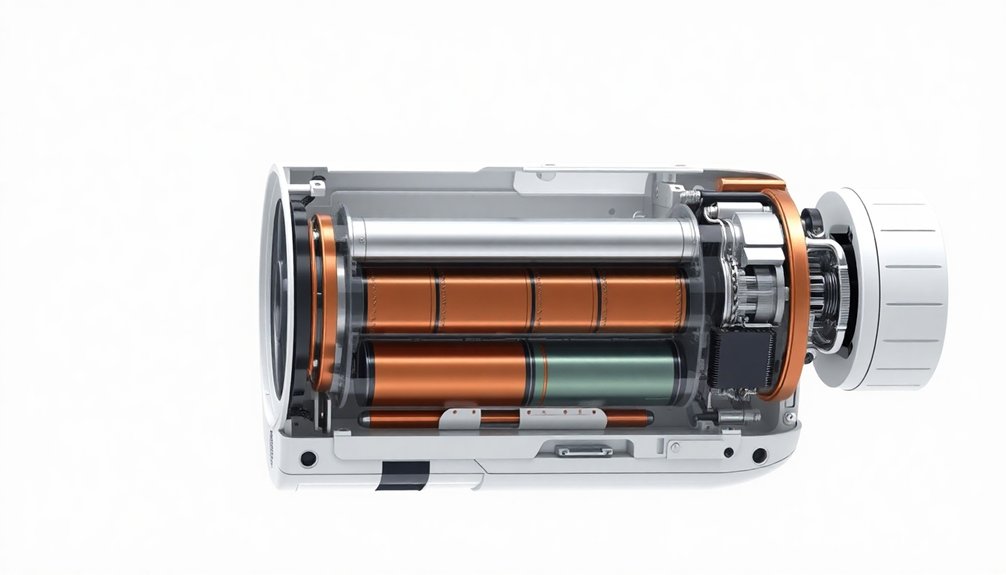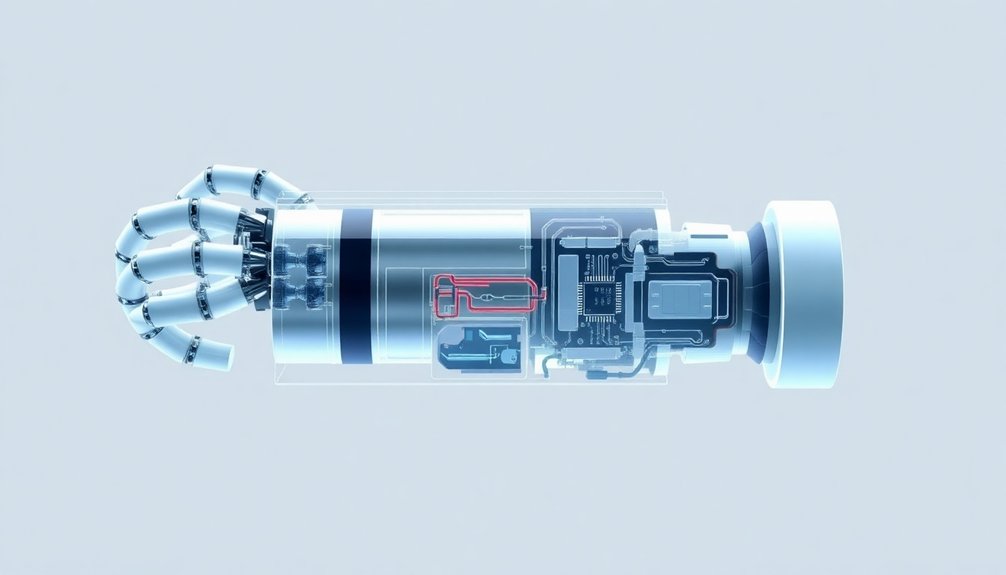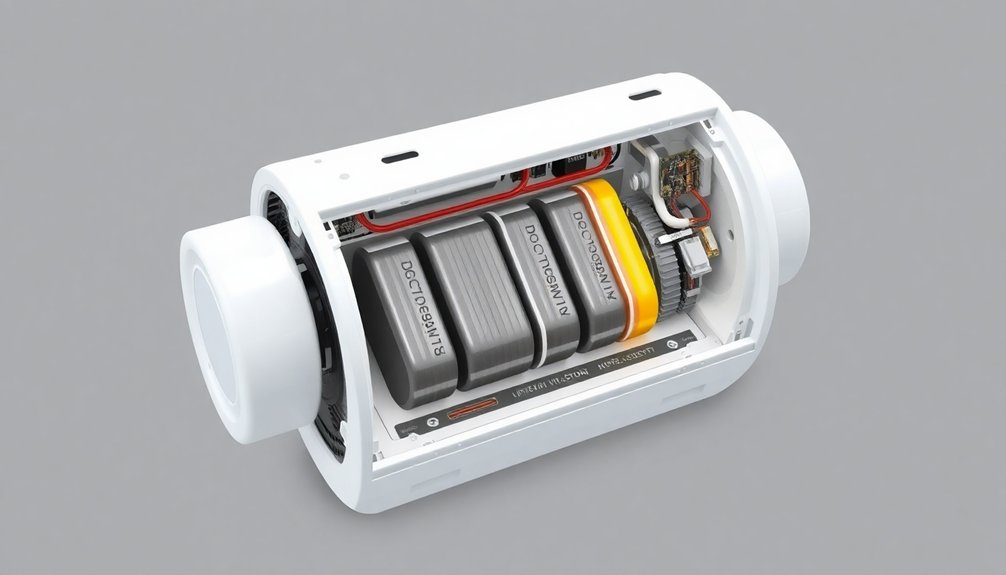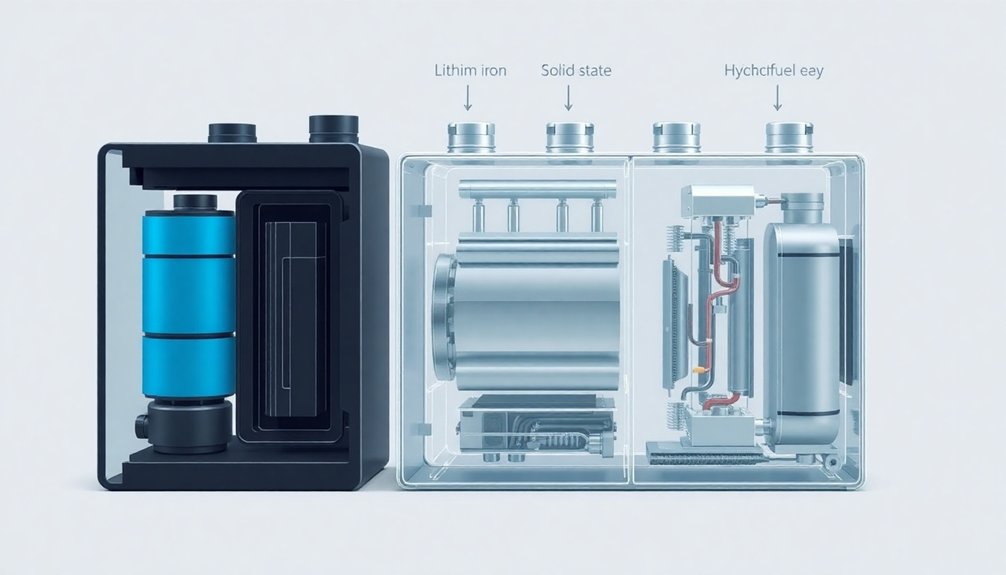Robots run on high-tech batteries that are basically their metabolic lifeblood. You’ll find these power systems packed with smart tech like solid-state batteries and AI-driven energy management that optimize every electron. Temperature, motor demands, and environmental conditions constantly challenge battery performance. Think of it like a robot’s diet — some batteries are lean and efficient, while others are energy-guzzling monsters. Curious about how robots stay charged and ready? Stick around.
Understanding Robot Battery Technologies

Power cells: the unsung heroes keeping robots from becoming expensive paperweights. Battery technologies are the silent engines driving robotic innovation, with energy density being the critical metric that separates functional machines from glorified toys.
You’ll want to understand how power management can transform a sluggish robot into an efficient marvel. Solid-state batteries and AI-powered battery management systems are revolutionizing operational uptime, pushing beyond traditional lithium-ion limitations.
Imagine robots that optimize energy consumption so smartly they practically breathe efficiency. Current systems range from 2-5 years of life, but emerging technologies promise even more impressive performance.
Think of it like giving your robot a metabolic upgrade — more energy, longer runtime, less downtime. The future of robotics isn’t just about fancy circuits; it’s about smarter, more sustainable power solutions.
Key Factors Affecting Battery Performance
When you’re diving into robot battery performance, it’s like understanding the secret sauce that keeps these mechanical marvels from turning into oversized paperweights.
Battery life isn’t just about how long your robot can dance before collapsing—it’s a complex ballet of energy efficiency and operational management.
Consider these critical battery performance factors:
- Power consumption of motors and sensors drains energy faster than a teenager’s smartphone
- Weight and load capacity determine how much juice your robot needs to strut its stuff
- Environmental conditions like temperature extremes can transform batteries into temperamental divas
- Thermal management strategies help reduce battery stress and extend mobile robots’ runtime
Your robot’s energy storage isn’t just science—it’s survival.
Want a machine that doesn’t quit? Pay attention to these power dynamics.
Power Consumption and Energy Management Strategies

Because robots aren’t magical perpetual motion machines, smart energy management becomes the difference between a high-performance marvel and an expensive doorstop.
Advanced battery management systems are your robot’s secret weapon for reducing downtime and maximizing energy efficiency.
Battery management: the hidden performance booster powering your robot’s most efficient moments.
Think of power consumption like a diet for machines: lithium-ion batteries need strategic optimization. Your robot’s operational environment plays a massive role in performance—temperature and humidity can dramatically impact runtime.
Want to keep your mechanical buddy humming? Focus on power-saving modes, intelligent component usage, and cutting idle energy waste.
Emerging battery technologies promise game-changing improvements, potentially transforming how we think about robotic energy.
The future isn’t just about more power—it’s about smarter power consumption.
Emerging Innovations in Robotic Power Systems
If you thought robot power systems were boring, buckle up for a wild ride into the future of machine energy.
The next generation of battery systems is about to blow your mind with jaw-dropping innovations:
- Solid-state batteries that pack more punch and safety than your smartphone’s tired lithium-ion
- Graphene batteries charging faster than you can say “power up”
- AI-powered battery optimization that learns and adapts like a power-hungry robot brain
- Wireless charging technologies that let robots juice up without human intervention
Energy efficiency isn’t just a buzzword anymore—it’s a revolution.
Synthetic metabolic systems might soon let robots “eat” metal for fuel, extending operational runtimes from hours to days.
Imagine robots that can digest aluminum like a high-tech meal, powered by cutting-edge battery tech that turns science fiction into reality.
Best Practices for Extending Robot Battery Life

Since battery life can make or break a robot’s performance, smart operators know that extending power runtime isn’t just a techie obsession—it’s survival. By optimizing energy management, you’ll keep your mechanical buddies running longer and smarter.
| Strategy | Impact |
|---|---|
| High Energy Density Batteries | Increased Runtime |
| Battery Management Systems | Proactive Health Monitoring |
| Reducing Idle Consumption | Extended Operational Time |
| Proper Charging Habits | Battery Longevity |
| Energy-Saving Modes | Power Efficiency |
Reducing downtime means choosing batteries that pack serious punch. Lithium-ion and emerging solid-state technologies aren’t just buzzwords—they’re your robot’s lifeline. Implement smart battery management systems, turn off unnecessary components, and watch your robotic companions transform from power-hungry machines to lean, mean, energy-efficient teammates. Who said robots can’t be power-saving ninjas?
Environmental and Sustainability Considerations
While robots might seem like eco-warriors of the future, their battery habits tell a different story. Robotic systems often struggle with environmental sustainability, creating significant e-waste challenges.
Battery production and disposal generate massive pollution, turning these high-tech helpers into potential environmental nightmares.
Battery production’s dark side transforms innovative tech into ecological hazards, polluting our planet with each robotic advancement.
Key sustainability concerns include:
- Energy-inefficient designs consuming excessive power
- Toxic materials leaching from discarded batteries
- Limited recycling infrastructure for complex battery technologies
- High carbon footprints throughout robotic lifecycles
Emerging innovations offer hope. Solid-state and lithium-sulfur batteries promise longer lifespans and reduced environmental impact.
By prioritizing energy-efficient designs and exploring sustainable materials, we can transform robots from waste generators into genuine green technologies.
The future isn’t just about creating smarter robots—it’s about creating responsible ones that don’t destroy the planet in the process.
Future Trends in Robotic Energy Solutions

When the world of robotics meets cutting-edge energy solutions, something magical happens—and it’s not just your sci-fi fantasies coming to life.
Imagine robots that can literally eat aluminum to generate power or distribute energy through their entire body like biological systems.
Battery technology is evolving rapidly, promising energy densities that’ll make current power sources look like ancient relics.
Robotic metabolism isn’t science fiction anymore—it’s emerging research turning robots into self-sustaining machines.
Synthetic and fluid-based energy systems are transforming how robots think about power, making autonomous energy sourcing a real possibility.
The future isn’t just about longer operational runtimes; it’s about creating adaptable, resilient machines that can hunt down their own energy like digital predators.
Who wouldn’t want a robot that powers itself?
People Also Ask About Robots
What Is the Power Source of a Robot?
You’ll typically power your robot with lithium-ion batteries, which provide an ideal balance between energy density and weight. These batteries enable efficient operation, with emerging technologies promising even better performance and longer runtime.
What Provides Energy for the Robot to Do Work?
Ever wondered how robots spring to life? You’ll find batteries are their primary energy source, converting stored electrical power to drive motors, sensors, and computing systems that enable robotic performance and task execution.
What Forms of Energy Does a Robot Use?
You’ll primarily use electrical energy from lithium-ion batteries, converting stored chemical energy into mechanical motion. Some robots also harness solar power or experimental synthetic metabolic processes to generate and utilize electrical energy for their operations.
What Is the Power System in Robotics?
Like a heart pumping life into a body, a robot’s power system relies on lithium-ion batteries. You’ll find voltage regulation and thermal management essential for efficient energy distribution, ensuring your robot’s reliable and dynamic performance.
Why This Matters in Robotics
You’re standing at the edge of a robotic revolution where power isn’t just about batteries—it’s about smarter, cleaner energy ecosystems. Like a Swiss Army knife of innovation, future robots will adapt, optimize, and survive on increasingly efficient power systems. Whether you’re excited or skeptical, one thing’s clear: the way robots consume energy is about to get a serious upgrade. Stay tuned, stay curious, and watch this technological transformation unfold.
